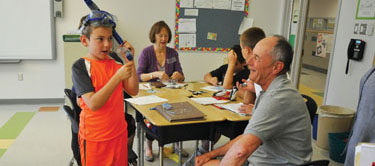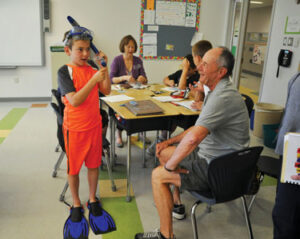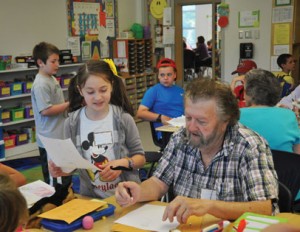

Nancy Arsenault
By Nancy Arsenault
The buzz in the room is louder than anything usually allowed in a classroom. Up and down activity from the seats is welcomed instead of discouraged. What else is different? While the setting is the Center Elementary School, many of these students are 60, 70 and 80 years of age.
That’s just a small snapshot of the inaugural Bridges to Generations program going on in Center’s 4th grade classrooms, involving 16 Stow seniors, and about seventy 10-year-olds. Every Tuesday, for six weeks, these seniors have made their way to classrooms where they are greeted by name by excited students looking forward to the visits and the topic of the day.
Bridges is not just a “Get to Know You” session, but a multi-week curriculum that engages both young and old in an awakening of the realization that everyone can learn from each other, regardless of age. Alyson Toole and the COA have been working to develop the program for over a year, creating something that would appeal to Stow’s seniors and be attractive to the educators at Center School. One recent week, both generations were challenged to bring something unique to demonstrate and teach to each other.
As one might expect, the majority of 10-year-old boys chose a form of sport, and the seniors were up for the game. Elder Bob Mong was intently learning the stick handling required of an ice hockey player, using an actual stick to get the proper movements down, under the tutelage of his young teacher, Andrew Matthews. Tablemate Jack Boyle adeptly juggled a soccer ball, demonstrating various techniques to get into scoring position, encouraging the seniors to get their foot on the ball. Mrs. Milton’s classroom saw a table of seniors donning a snorkel mask, passed around by student Jason Perreault as he extolled the virtues of underwater exploration. “I could really show you better using the sink,” said Jason, an option denied by his classroom teacher.
Students and teachers went back and forth in all seriousness. The students displayed patience and desire for their senior partners to love their particular sport as much as they do and at the same time, enthusiastically attempted to try whatever was placed before them by the seniors. Seniors wielded lacrosse sticks, tossed footballs and learned about favorite players, amazing even themselves at what they were able to do when prompted by the kids. The children learned domestic and craft skills and listened to stories of travels near and far collected over the lifetimes of their senior partners.
According to the Council on Aging, it was initially difficult to get seniors to sign up for the program, with many feeling they could not relate to or would not be welcomed by the younger people. “We have fun with them,” said 4th grader Anthony DeFoe. ”They aren’t just here.” Each week, a pair of seniors sits at a table with the same group of six students, getting to know each other more and more as the weeks progress. And according to the classroom teachers, as the program evolves, so does the level of chatter and activity at the tables. “I was hooked from the first day,” said Bob Mong.

Nancy Arsenault
During the demonstration week, seniors were just as anxious as the youngsters to convey their knowledge. For Alex Gray, a resident of Plantation Apartments, his proficiency as a Harley motorcycle rider really grabbed the students’ attention. While the names of engine components and mechanical virtues may have sailed over their heads, the students were quite interested in Alex’s tales of roadtrips around the country. Other seniors who love to travel showed off pictures of Alaskan cruises and the wildlife they saw, or collections of Native American dolls gathered during a vacation through the western states.
Senior Barbie Wolfenden felt that a lesson on valuable life skills may be in order for this age group, whom she was taking through the steps of sewing on a button. “This is way harder than putting a worm on a hook,” said student Nick Werner, who after several minutes of trying finally brought the thread through the hole. “I did it,” he said enthusiastically. This table of all boys saw their task through to the end, resulting in a button sewn tightly onto little snippets of fabric provided by Wolfenden.
While the curriculum plan provides a topic from which conversations can build, there seemed to be no awkward moments or silence within the groups. It was obvious that the topic is just a small part of the conversations taking place, with the kids asking questions of the seniors that perhaps haven’t been asked of them for quite some time. Many want to know what life was like when the seniors were 10 years old, what they did for fun, what their school day was like. “It’s fun to learn about what happened back then,” said Josh Kerble.
By the end of the one hour session, the groups reluctantly disperse. The classroom teachers remarked that it’s difficult for the groups to stop talking, sharing and interacting. “We really don’t have enough time,” said student Vivien Stringfellow of the sessions she has enjoyed. “My group always gets carried away with our topics,” added Henry Gerecke, one of the boys who learned to sew.
“And to think I almost didn’t do this because I thought I wouldn’t know how to talk to 4th graders,” said Alex Gray, taking in all the farewells from the students at his table. “It’s wonderful for a senior to see how advanced these children are and it helps the children to see that we may be 88, but we’re not dead yet,” laughed Eileen MacDonald.
The Bridges students and the seniors will enjoy a party at the COA next Tuesday, to close out their program.